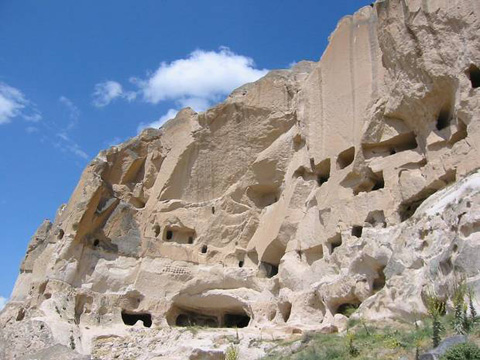Vast 5,000-year-old underground city discovered in Turkey's
Cappadocia region
A 5,000 year-old underground city thought to be the largest in the
world has been discovered in central Turkey.
The subterranean settlement was discovered in the Nevsehir province
of Turkey's Central Anatolia region, in the historical area of
Cappadocia. Cappadocia is famous in archaeological circles for its large
number of underground settlement.
But the site, located around the Nevsehir hill fort near the city of
Kayseri, appears to dwarf all other finds to date.
Hasan Ünver, the mayor of the city on those outskirts the discovery
was found, said other underground cities were nothing more than a
"kitchen" compared to the newly uncovered settlement.
|

The city may be the biggest in the world |
Mehmet Ergün Turan, the head of Turkey's housing development
administration, said the discovery was made during the groundwork for a
housing project meant to develop the area.
"It is not a known underground city. Tunnel passages of seven
kilometers are being discussed. We stopped the construction we were
planning to do on these areas when an underground city was discovered,"
Turan told Turkish publication Hurriyet Daily News.
The agency has already spent 90 million Turkish liras (£25m) on the
development project, but the organisation's head said he did not see the
money spent as a loss due to the magnitude of the historical
discovery.The upper reaches of the city were first spotted last year but
it was not until now that the size of the discovery became apparent. The
organisation has so far taken 44 historical objects under preservation
from the site.
The area has been officially registered with Turkey's Cultural and
Natural Heritage Preservation Board and no further building work will be
done.
The Cappadocia region, once a Roman province, is fertile ground for
underground cities because of its soft volcanic rock which is easy to
carve.
Nevsehir province's most renown underground settlement is Derinkuyu,
a multi-level city large enough to house many thousands of people and
their livestock. It lies within an hour's drive south of the new
discovery. Derinkuyu, believed to date to the 8th century BC, was most
recently inhabited by Christians until 1923 when they were expelled
during a population exchange with Greece.
It has since laid uninhabited and draws visitors from around the
world.
- The Independent
|

